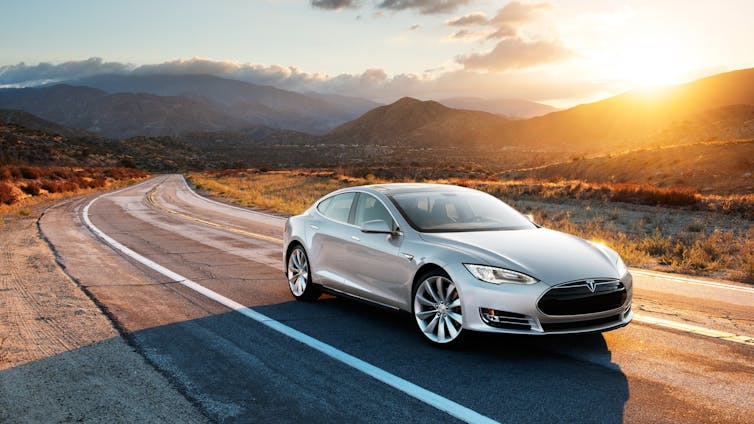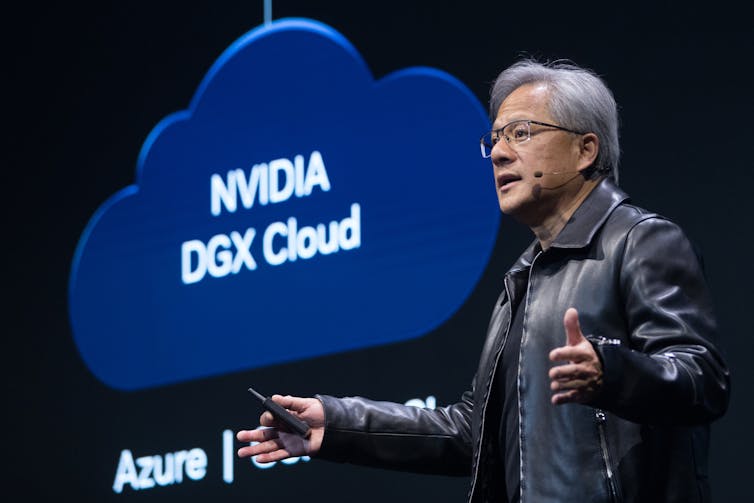Apple, Tesla and Nvidia were among 2023’s ‘magnificent seven’ stocks – here’s what to expect from them all in 2024
By Karl Schmedders, International Institute for Management Development (IMD)
In the 1960 western The Magnificent Seven, a group of seven gunfighters protect a village from bandits. Only three survive to ride out of town at the end of the movie. The odds look much better for the seven tech companies recently dubbed the magnificent seven after dominating US stock markets in 2023. But there are problems that could ambush some of these companies in 2024.
Apple, Alphabet, Microsoft, Amazon, Meta, Tesla and Nvidia have driven a rally in US stocks in 2023. They now make up nearly a third of the S&P 500 measure of the largest listed US companies, which has risen more than 20% since January. These tech stocks had provided shareholders with a whopping 71% return by mid-November while the other 493 names added just 6%.
This impressive performance led Bank of America analyst Michael Hartnett to name these companies the magnificent seven earlier this year. Goldman Sachs soon followed, calling their massive outperformance the “defining feature” of the equity market in 2023.
But as dramatic as this performance has been – and although they’re all essentially tech companies – don’t make the mistake of thinking they’re all the same. In fact, the outlook for the magnificent seven next year is mixed, particularly in light of expected changes in their core markets.
Rising competition in the EV market
Let’s start with the bad news first. Electric vehicle (EV) manufacturer Tesla Motors will continue to lose market share in 2024. While chief executive Elon Musk has been dealing with advertising problems on X (formerly Twitter), one of his other businesses, over the first three quarters of this year, Tesla has seen its US market dominance shrink from 62% to just over 50% of the market. Both BMW Group and Mercedes-Benz Cars have expanded their footprints.
And over the next few years, the growing global heft of Chinese manufacturers looks hard to beat. Chinese EV players such as BYD, Nio, Wuling and Xpeng produced almost 60% of the world’s EVs in 2022 – and they have been doing so in a very affordable manner. In the first half of 2023, the average cost of an EV in China was US$33,000 (£26,040), more than half the US$70,700 (£55,800) people pay for EVs in Europe and the US$72,000 (£56,800) paid in the US.
US president Joe Biden has proposed strict new car pollution controls that will require almost two-thirds of new cars sold in the US to be electric by 2032. But the cost of EVs will need to come down if they are to achieve mass market appeal.

Sunny outlook for cloud computing
Magnificent seven members Amazon, Microsoft and Alphabet make up two-thirds of the cloud computing market, which will continue to grow in 2024, although perhaps not quite as much as in the past.
Still, the market for cloud infrastructure services is expected to expand from US$122 billion in 2023 to US$446 billion by 2032. In particular, concerns about the macroeconomic environment have seen some customers focus on using the cloud more to reduce costs in recent years, although this has yet to have any meaningful impact on revenues.
And for Amazon in particular, there are some niggling questions around its outlook. Although its cloud business remains solid, its original e-commerce business has seen growing competition recently, notably from rival retail giant Walmart, which is eating into its business in the US.
This is one reason why holding Amazon shares provided an annual return over the past two years of -16.7%, as of early December, according to my calculations.
Unstoppable AI
Also linked to the cloud computing industry, California-based chip maker Nvidia Corporation has been the runaway success of the magnificent seven this year. This is all thanks to its dominance in processing AI workloads on the cloud. The majority of cloud players use Nvidia graphics processing units (GPUs).
But while its two-year return of 43.3% is the most impressive of the seven tech companies, there are competitors on the horizon that could nibble away at some market share.
Nvidia’s nearest rival AMD drew attention with its latest chip offering in 2023 – it’s betting the market will be worth US$400 billion by 2027. A number of other start-ups are also developing chips for niche AI fields.
Can Nvidia maintain its dominance? If it does, its earnings will skyrocket alongside the growth of AI. But even if it loses some market share, the AI market will boom for years.

The outliers
For those keeping track, that just leaves two final members of the magnificent seven.
Apple Inc – the world’s largest company by market capitalisation – consistently delivers solid returns: 16.2% over the past two years by my calculations. At the other end of the scale, social media company Meta (owner of Facebook, Instagram, Threads and WhatsApp) is the only one of the group to have shown an essentially flat stock market performance over the past two years.
Although Meta’s revenues and earnings have consistently beaten expectations this year, the threat of anti-trust legislation in the US and Europe hangs over the company, as does an advertising market that is bottoming out. Both of these issues could harm Meta’s revenue outlook next year.
So, the magnificent seven have all survived to ride out of town at the end of 2023, but it’s as clear as a tumbleweed rolling down a deserted main street that not all of them are in for a leisurely horseback ride through 2024. Saddle up, partners!![]()
Karl Schmedders, Professor of Finance, International Institute for Management Development (IMD)
This article is republished from The Conversation under a Creative Commons license. Read the original article.



